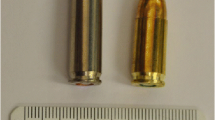Abstract
The use of less lethal weapons aims to mitigate civilian casualties caused by firearm use. However, due to numerous cases in which these weapons caused serious injuries, even lethal injuries, both legislation and the forensic field are interested in characterizing and regulating them better. In the forensic field, there is a lack of strong research about injury patterns of these weapons which makes it difficult to identify the type of weapon employed. In this study, the main objective was to characterize the injury pattern produced by the impact of the 9 mm P.A.K. projectile. A porcine model was used. Four different distances were studied: firm contact, 10 cm, 60 cm and 110 cm, using 3 of the more representative anatomical sites: the head, the hind leg and the ribs. The average measurement of the entrance orifice varied according to the anatomical site, being 6.67 mm wide and 6.25 mm long in the thorax, 7.3 mm wide and 8.8 mm long in the hind legs, and 7.62 mm wide and 7.54 mm long in the head. The variation in width and length measurements was not found to be directly related to the shot distance. The gunshot residues had similar characteristics to those of conventional lead projectiles, however there was more unburned powder deposit near the wounds, with a less dense soot and more dense powder tattoo. Depth varied widely regardless of tissue and firing distance, although loss of penetrating power and injury is observed as one moves away from the target.



Similar content being viewed by others
References
Geneva, Academy (2018) Geneva guidelines on Less-Lethal weapons and Related Equipment in Law Enforcement. Text for consultation
Wyant RT, Burns T, Allgire J (2014) Risk management of less lethal options. https://doi.org/10.1201/b16847
Haar RJ, Iacopino V, Ranadive N, Dandu M, Weiser SD (2017) Death, injury and disability from kinetic impact projectiles in crowd-control settings: a systematic review. BMJ Open 7:1–9. https://doi.org/10.1136/bmjopen-2017-018154
Millar R, Rutherford WH, Johnston S, Malhotra VJ (1975) Injuries caused by rubber bullets: a report on 90 patients. Br J Surg 62:480–486. https://doi.org/10.1002/bjs.1800620613
Hiss J, Hellman FN, Kahana T (1997) Rubber and Plastic Ammunition Lethal injuries: the Israeli experience. Med Sci Law 37:139–144. https://doi.org/10.1177/002580249703700209
Kobayashi M, Mellen PF (2009) Rubber bullet injury: case report with autopsy observation and literature review. Am J Forensic Med Pathol 30:262–267. https://doi.org/10.1097/PAF.0b013e318187dfa8
Beatty JA, Stopyra JP, Slish JH, Bozeman WP (2020) Injury patterns of less lethal kinetic impact projectiles used by law enforcement officers. J Forensic Leg Med 69:101892. https://doi.org/10.1016/j.jflm.2019.101892
Frank M, Peters D, Klemm W, Grossjohann R, Ekkernkamp A, Bockholdt B, Seifert J (2017) Penetrating chest trauma caused by a blank cartridge actuated rubber ball projectile: case presentation and ballistic investigation of an uncommon weapon type. Int J Legal Med 131:1307–1312. https://doi.org/10.1007/s00414-017-1606-6
Ogunc GI, Ozer MT, Coskun K, Uzar AI (2009) Modified blank ammunition injuries. Forensic Sci Int 193:112–117. https://doi.org/10.1016/j.forsciint.2009.09.021
Pircher R, Große Perdekamp M, Thierauf-Emberger A, Kramer L, Pollak S, Geisenberger D (2017) Wound morphology in contact shots from blank cartridge handguns: a study on composite models. Int J Legal Med 131:1333–1339. https://doi.org/10.1007/s00414-017-1650-2
DiMaio V (2015) Gunshot wounds. CRC Press. https://doi.org/10.4324/9780367805715
Sinha JK (2014) Forensic investigation of unusual firearms: ballistic and medico-legal evidence. CRC. https://doi.org/10.1201/b17679
Humphrey C, Kumaratilake J (2016) Ballistics and anatomical modelling – a review. Leg Med 23:21–29. https://doi.org/10.1016/j.legalmed.2016.09.002
Miles KL, Finaughty DA, Gibbon VE (2020) A review of experimental design in forensic taphonomy: moving towards forensic realism. Forensic Sci Res 5:249–259. https://doi.org/10.1080/20961790.2020.1792631
Aerssens J, Boonen S, Lowet G, Dequeker J (1998) Interspecies differences in bone composition, density, and quality: potential implications for in vivo bone research. Endocrinology 139:663–670. https://doi.org/10.1210/endo.139.2.5751
Fragkouli K, Al Hakeem E, Bulut O, Simmons T (2018) The effect of range and ammunition type on fracture patterns in porcine postcranial flat bones. J Forensic Leg Med 53:1–12. https://doi.org/10.1016/j.jflm.2017.10.004
Breeze J, Carr DJ, Mabbott A, Beckett S, Clasper JC (2015) Refrigeration and freezing of porcine tissue does not affect the retardation of fragment simulating projectiles. J Forensic Leg Med 32:77–83. https://doi.org/10.1016/j.jflm.2015.03.003
ZSR, ZSR-Katalog (2023) 68. https://www.zsrpatlayici.com/files/ZSR-Katalog.pdf (accessed April 15, 2023)
Cohen H, Kugel C, May H, Medlej B, Stein D, Slon V, Hershkovitz I, Brosh T (2016) The impact velocity and bone fracture pattern: forensic perspective. Forensic Sci Int 266:54–62. https://doi.org/10.1016/j.forsciint.2016.04.035
Carlucci DE, Jacobson SS (2018) Ballistics. Third edition. | Boca Raton: Taylor & Francis, CRC Press; 2018. 282, 601. https://www.taylorfrancis.com/books/9781351678674
Acknowledgements
We would like to thank the personnel of the ballistics laboratory of the National Institute of Legal Medicine and Forensic Sciences of the basic unit Cali, who helped to set up the experiment and carry out the shooting. Also, we thank professors from the Department of Public Health and Epidemiology of the Pontificia Universidad Javeriana Cali, who supported the whole process of experimental design and statistical analysis.
Author information
Authors and Affiliations
Corresponding author
Ethics declarations
Conflict of interest
The authors report no conflicts of interest.
Additional information
Publisher’s Note
Springer Nature remains neutral with regard to jurisdictional claims in published maps and institutional affiliations.
Electronic supplementary material
Below is the link to the electronic supplementary material.
Rights and permissions
Springer Nature or its licensor (e.g. a society or other partner) holds exclusive rights to this article under a publishing agreement with the author(s) or other rightsholder(s); author self-archiving of the accepted manuscript version of this article is solely governed by the terms of such publishing agreement and applicable law.
About this article
Cite this article
Moreno, N.C., Zambrano, J.P., Dorado, L.F. et al. Assessment of injuries patterns produced by a 9mm P.A.K “rubber ball” blank firing weapon: porcine model. Int J Legal Med (2024). https://doi.org/10.1007/s00414-024-03238-8
Received:
Accepted:
Published:
DOI: https://doi.org/10.1007/s00414-024-03238-8




